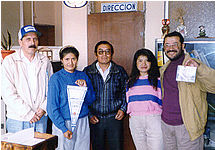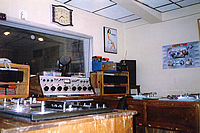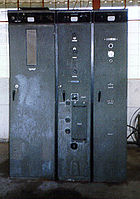ERPE,
Riobamba, Ecuador, broadcasting on 5011 kHz is again on the
air. Heard March 30 at 0020-0058 with ID as "Escuelas Radiofónicas
Populares del Ecuador"
Yimber
Gaviria, via Conexion, March 30, 2000
Struggling on
with old transmitter
By Nick Grace C.
Riobamba is a popular destination for tourists who want to
climb the monolithic volcano, Chimborazo, at 6310m above sea
level. The town center is lined with cobblestone streets and
colonial houses, a refreshing change from the bustle of Ambato.
Elsa and I decided to waste no time and jumped into a taxi
to go straight to the city’s Escuelas Radiofónicas Populares
del Ecuador (ERPE.) By now the clock was nearly striking
three and only God knows when the business day is considered
over in Ecuador.
We found the station's villa by its modest sign hanging
over the door. Inside, a nurse directed us to the stations
office just beyond a little courtyard and garden.
We walked in and met with staff member Ruben, whom I was relieved
to see smoking at his desk. Thank God "smoke-free"
hasn't entered into Ecuadorian conscienceness yet, I thought.

Lauro,
Maria, Ruben, Ana, Juan (from left
to right) |
I offered
him a clove cigarette to break the ice and we began to chat
about various political scandals in our two countries.
Soon the room was filled with smoke and nearly ten people,
including two well-known verification signers: Juan Pérez
Sarmiento (ERPE Executive Director) and his secretary Maria.
(Here was undeniable evidence that not only are verification
signers real, but they also have human urges and addictions,
like smoking! Now I understand where all those dollars
to unanswered follow-up reports are going to: Marlboro's!)
ERPE,
the radio station, is one of three projects for their foundation,
which also includes a small hospital and a group of farms
to export a cereal called quinia to the U.S.
The station began on March 19, 1962, and has nearly run its
1kW transmitter into the ground. In fact, it was off the air
in the mid-nineties after its tubes burned out.
Besides operating on 5010 kHz to Riobambans who live in Quito,
Guayaquil and other cities, ERPE airs on 710 kHz and 91.7
MHz FM for the local populace.
Listeners can hear the stations educational programs
on 5010.1 kHz between 0000 and 0200 GMT nightly. Unfortunately,
they are using only 500 to 800 watts in order to preserve
the equipment, and when the time comes that a replacement
is needed ERPE will probably lose its SW voice. Reports are
promptly answered with a letter and, when available, large
pennants which reflect the projects community orientation.
 Juan
invited me to the FM studio for a live on-air interview about
youth and the Latino community in the United States, and so
we headed over. Like Radio Centro, the announcers sit in a
separate room from the producer. The MW and SW studio is across
the hall, but it was not being used at the moment. Juan
invited me to the FM studio for a live on-air interview about
youth and the Latino community in the United States, and so
we headed over. Like Radio Centro, the announcers sit in a
separate room from the producer. The MW and SW studio is across
the hall, but it was not being used at the moment.
After the interview, we took a stroll into a classroom and
Juan showed me the foundation's growing collection of radio
station pennants. He said that they're useful to educate
students about the world around them. We then returned
to the office, where engineer Lauro offered to take Elsa and
I to see the antenna and transmitter. I thanked the friends
I'd met and hopped into his car for the 20-minute ride.
The three of us pulled into a section of farmland and
more or less bounced through what once was a road until we
came upon the site. ERPEs MW tower and SW dipole lie literally
in the massive shadow of the snow-capped Mt. Chimborazo. I
stood in awe of the folded dipole hanging between two 50 towers,
as if juxtaposed over the sleeping volcano. Off to the side
of the antenna is a traditional Indian hut, where the stations
guard appeared. Lauro explained to me that the guard doubles
as a farmer for their export project and pointed to the cultivated
ground. This is the quinia weve been talking about, he laughed.
 Within
a large shed live the MW and SW transmitters. Within
a large shed live the MW and SW transmitters.
The SW unit, standing over 6 tall and 4 wide, was donated
almost forty years ago by a French foundation.
I was amazed to stare into the monolith the same monolith
that rides through the static every night with the music and
programs of ERPE.
After taking a few pictures, Lauro drove us back to Riobamba
where we found another bus. We hopped on as the sun
went down and headed straight for Baños, a venerable tourist
trap. Elsa had called a friend of hers who lives there
and got permission for us to stay the night. Little
did I know how interesting things were about to become.
Copyright
©1998 by Nick Grace C., All Rights Reserved
Permission to reproduce and/or quote information from this
site for non-profit, educational purposes is freely granted,
always provided that proper reference of the site and sources
be included. Reproduction and/or citation for profit and/or
non-educational purposes is expressly forbidden without
prior consent from the author.
|